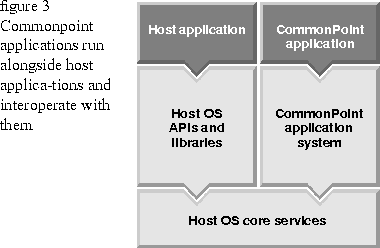In addition, as suggested by Figure 3, applications written for the host
operating systems can run at the same time as CommonPoint applications and can
interoperate with them, thus preserving customers' software investments. Both the
host operating system and the CommonPoint application system use the same
low-level host protocols (labeled "Host OS core services" in Figure 3) to
communicate with the underlying 32-bit (and higher) hardware. Taligent provides its investors and other key partners with a
reference release, currently running on AIX, for each new version of the
CommonPoint application system and the CommonPoint Developer Series. When
Taligent or any other company ports a Taligent reference release to a new host
operating system, the newly ported version provides the interface code required
to map the standard CommonPoint and cpProfessional APIs to the low-level host
protocols. Before Taligent or any third party can make such a port available
commercially, the ported version must pass a suite of tests to certify that it
supports the APIs and other standards established by Taligent's reference
release.
Taligent will administer these tests at first, with the goal of eventually making
them available to an independent organization such as the Object Management Group
or the X/Open standards organization. This testing process ensures that all
CommonPoint implementations work the same way and provides branding for certified
implementations, which can then use the CommonPoint logo. 
[Contents]
[Previous]
[Next]